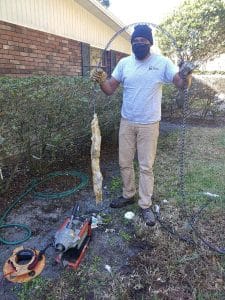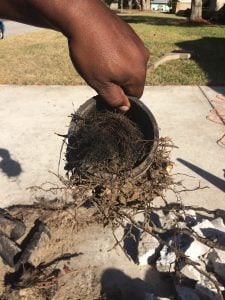Cleaning Clogged Drains

Cleaning Clogged DrainA clogged drain in your home may be caused by flushed solids or damaged drainpipes. Before you run to your local hardware store and grab a bottle of your favorite drain cleaner, you should diagnose your problem further. We are not suggesting that a drain cleaning solution such as Drano doesn't work or relieve clogged drains rather, that it's not the only solution and often homeowners expect it to be. before we jump into the solution options lets first understand how drains work and their differences.
How Does a Toilet Drain Works?
A toilet drain system functions mainly by gravity. A toilet has two major parts, the toilet bowl and the water tank. When you press the lever on the water tank it opens its drain and rushes water into the bowl. The water level than rises above the highest point of the bowl's draining point or the top of the trap's outlet, and the waste is flushed down the main drain in your floor. Here you can view a toilet part chart for all the individual parts that make a toilet function.
Common Clogged Toilet Problems
Most toilet drains are clogged the trap, that "s" shape you between your toilet bowl and the wall. The trap is the first challenge the solids and waste have to concur on their way to the main sewer drain. The trap has turns and bends which can be too narrow often at the bends or turns inside the trap area. These types of clogs or drain stoppages do not require special treatments, chemicals or a drain rooter plumber, they simply need a good plugger.
Toilet's Main Drain Problems
Past the toilet's trap and below the fixture is a system of main drainpipes. The toilet's main drain typically starts with a flange which is at the floors surface (where the wax ring is) followed by a 90-degree elbow that will send the flushed waste to the main drain line. Main line stoppages as referred to by professional plumbers can be a little more difficult to relieve and will resist most store purchased drain cleaning remedies. main drain cleaning is often unclogged with a power machine like those sold by Ridgit, most commonly known as "Plumber's Snake". This process can be executed by removing the toilet off the floor or by inserting the snake via a clean-out outside your home. Some plumbers will resort to an unrecommended procedure which inserts the snake through the toilet vent on your roof. We will not get into all the details of why you shouldn't clean a drain through the roof vent, but it's not recommended.

NOTE: Most new construction will use a 4" pvc drain but sometimes builders will use a 3" drain than connect it to a 4: main drain. In general, a 4" drain will flush and can drain twice as much as 3" drain. So, if you are remodeling or building a new home, ask your plumbing contractor to install 4" drains and drainpipes for all your toilets.
How Does a Sink Drain Work?
Both kitchen and bathroom drain function similarly. Sink drains have a p-trap which by design is to stop sewer gases from coming back up through your drain and into your home. The p-trap is that "U" shape that is seen under your sink. When you open the faucet water will drain into the p-trap and once it rises above the p-trap's highest exit point it will drain into your main sewer line. Unlike your toilet, sink drainpipes are small in diameter and have less ability to flush solids.
Common Clogs in Sink Drains
Common sink drain problems are hair in bathroom sinks and deposit in kitchens sink drain. Although the drain plumbing design is similar, the source of use is not so, let's take a look at each.
Bathroom Sink Drains
A bathroom sink drain is equipped with a drain stopper or drain pop-up stopper. drain stoppers are great in allowing you to fill-up you sink for various uses however, they are often the culprit in clogging your drain. These stoppers are a "catch all", they catch and hold on to hair, small debris and solids. Although a slow draining bathroom sink may seem to be a plumber's job, they're not, it's actually easy and simple to clean any clog or obstruction jammed at the stopper. To clean a sink drain stopper simply disconnect the pivot rod and pull the stopper out.

Kitchen Sink Drain
Kitchen sinks like those used in residential applications are with or without the addition of a garbage disposal attachment. Kitchen sinks without garbage disposal attachment will function the same as those you find in the bathroom (see above for more details). However, those sinks which have a garbage disposal units attached require a little more understanding and diagnostic in order to troubleshoot a drain clog. A sink with a garbage disposal unit will first drain into the disposal unit. The garbage disposal unity is responsible for reducing the solids to a drainable size. If the unit is not successful at doing so, you will develop a slow drain or clogged drain within the unit. Another common drain problems in kitchen sinks are caused by sediment or deposits which build at the bottom of the p-trap of drainpipes. Example, a grease that is not properly flushed down a drain will build-up on the walls of the drainpipe making the inside of the pipe smaller in diameter causing a slow draining condition. Also, fine -grained sediment can slowly settle and bind at the bottom of the p-trap which constrict the flow of the drain. You can clean your sink drain by simply placing a bucket under your p-trap opening the p-trap and cleaning it. If your sink drain problem is past the garbage disposal unit and p=trap you should consider calling a drain cleaning rooter plumber to further diagnose the problem.
What Happens When All the Drains in Your Home Are Slow?
If all the drains in your home are slow, you may have a main sewer line problem. But, before you jump to such conclusion and call a rooter plumber, conduct this test first. Testing one drain at a time, flush different fixtures around your home, start with your kitchen and move onto your bathroom, even flush your toilet. If you learn that every drain in your home is draining slow, you most likely have a clogged main drain. The main drain is a 4" sewer pipe that is responsible for collecting all the different drains in your home and delivering those to the city supplied sewer service aka "the street". The main sewer line travels under your home and most commonly through your front yard and towards the street.
Main Drain Problems - Sewer Line Problems
Not all main drain problems are an expensive repair. Often the same plumber snake approach we described above in the toilet section will provide the solution. Other sewer drain problems can be more complex and expensive, those are breaches to the line or sagging "belly" in the line.
Sewer Drain Line Breach
Sewer pipes can be damaged by nearby trees. Roots are notorious in breaching drain lines and making their way into the pipe. Over time these roots begin to catch solids flowing through the pipe and build a "dam" like stoppage in the flow. This kind of main line stoppage will cause all the drain in your home to drain slow and the solution is not cheap. When roots are the cause of main drain problems you should be advised to replace a section or the entire drainpipe as a permeant solution. The process requires permitting from your local municipality, excavation, removal of old pipe and installation of new drain line.

Drain Line Sag or Belly
Overtime a drain line may sag. This normal behavior causes a drop in the line that often fills with debris and sediment causing constriction in the flow. From time to time the belly or sag will also develop cracks which allows sand to sip into the line and decrease the ability of sewage to flow. I you have old cast iron or clay sewer drain lines; you should consider replacing them with new pvc lines in order to prevent recurring issues.
IMPORTANT: Before you make a decision to replace you drain line, ask the plumbing contractor or drain cleaning plumber to camera scope your lines and show you the source of the problem. Unless you see with your own eyes the damage or problem, do not hire a contractor or agree to commence on such project.

Cleaning Clogged Drain Conclusion
Most clogged drains do not require a plumber or a cleaning service, they simply need a little of your attention and will to maintain. Where drain clogs are not at the immediate drain it is best to schedule a drain cleaning rooter plumber. All main line stoppages should be cleaned and scoped with a camera to ensure the line is clean and there is no damage to the pipe causing your problem to return often. If you have severed build-up and deposits in your drainpipes, you should ask your drain cleaning plumber to hydrojet "jet" your sewer pipes. Hydrojetting is a process similar to pressure-washing the inside of your sewer lines. It can also descale the inside of the pipe which increases the diameter. More drain cleaning service options
Read More: How To Prevent Drain Clogs

